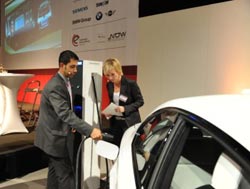Rapid Charging for Cars with DC and AC

This user-friendly solution was developed by Siemens and BMW for the Modellregion Elektromobilität München – Drive eCharged project. The partners’ goal with the project is to establish their charging concept as an international standard. The system utilizes plugs standardized for AC charging that have been modified to accommodate DC charging. Until now, electric vehicles that can be charged with either AC or DC needed to use two different sockets. The project partners recently presented a prototype of the new charging system in the Transportation section of the Deutsches Museum in Munich.
Charging times and vehicle range are key aspects that influence consumer acceptance of electric cars. Today’s batteries have to be recharged more often than a conventional vehicle needs to be refueled, and the recharging process also takes several hours when a conventional socket is used. Charging times of half an hour or less can be achieved with DC technology, however. Unlike AC systems, with DC technology the power converter is located outside the vehicle at the charging station, which means the cars that use it can be made lighter. This, in turn, increases vehicle range, and combined with short charging times it therefore makes electric vehicles more attractive to fleet operators. Special charging units are required for this system, however, which is why the Drive eCharged partners have developed a user-friendly approach that offers several advantages over the systems now in use. For example, AC and DC plugs fit into the same socket on the vehicle. The new approach also standardizes communication between the vehicle and charging station for AC and DC operations, which means it will be able to support additional functions like smart charging or bi-directional charging for both charging modes in the future. Over the medium term, it is expected that DC systems will be able to charge a vehicle to the equivalent of a 100-kilometer range in just 15 minutes.
The new system was successfully tested in September 2011 with a Siemens charging station and a BMW ActiveE vehicle, and Siemens and BMW have already submitted proposals for standardizing DC charging to the International Electrotechnical Commission (IEC). The two companies are planning to continue this work on standardization. The Modellregion Elektromobilität München – Drive eCharged project is being funded by Germany’s Ministry of Transport, Building, and Urban Development.
Media Contact
More Information:
http://www.siemens.de/innovationAll latest news from the category: Power and Electrical Engineering
This topic covers issues related to energy generation, conversion, transportation and consumption and how the industry is addressing the challenge of energy efficiency in general.
innovations-report provides in-depth and informative reports and articles on subjects ranging from wind energy, fuel cell technology, solar energy, geothermal energy, petroleum, gas, nuclear engineering, alternative energy and energy efficiency to fusion, hydrogen and superconductor technologies.
Newest articles

Superradiant atoms could push the boundaries of how precisely time can be measured
Superradiant atoms can help us measure time more precisely than ever. In a new study, researchers from the University of Copenhagen present a new method for measuring the time interval,…

Ion thermoelectric conversion devices for near room temperature
The electrode sheet of the thermoelectric device consists of ionic hydrogel, which is sandwiched between the electrodes to form, and the Prussian blue on the electrode undergoes a redox reaction…

Zap Energy achieves 37-million-degree temperatures in a compact device
New publication reports record electron temperatures for a small-scale, sheared-flow-stabilized Z-pinch fusion device. In the nine decades since humans first produced fusion reactions, only a few fusion technologies have demonstrated…





















